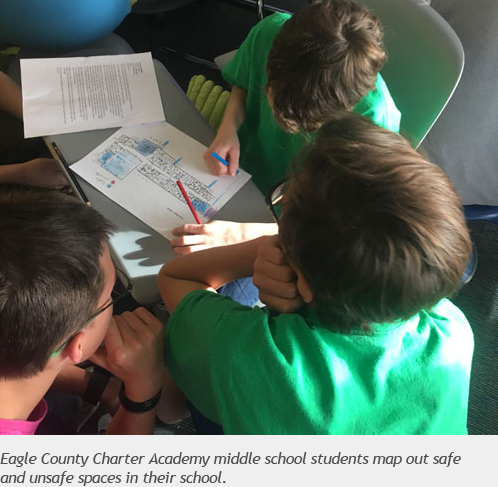
By Gabi Johnston | Office of Communications
When Eagle County Charter Academy students gathered to map out the safe and unsafe spaces in their school, they noted not feeling protected in some expected areas, such as the cafeteria and the outside spaces where students gathered during lunch.
The girls locker room also was on the list. The boys had to walk past it to get to their own, and the privacy curtain stopped a few feet from the floor, exposing part of the girls’ bodies.
When the students presented the information to school administrators, the problem was quickly resolved by relocating the girls locker room and providing better privacy.
But without the Hot Spot Mapping program, the change might never have been made.
Hot Spot Mapping is a relatively new program funded by the Colorado Department of Public Health and Environment. Participating students map out their entire school, pinpointing areas where they feel safe and those where they don’t. A safe space could be a classroom where the teacher knows everyone’s name and encourages honest discussion. It could be a hallway where there is plenty of adult supervision. Unsafe spaces, conversely, could be areas with minimal lighting or even an area in the parking lot in need of a stop sign. The program, according to participating school administrators, is an “amazing” tool that helps students feel safe in a place where they spend much of their lives.
The underlying benefit of the program is that it helps school staff build trusting relationships with students and empowers youth to solve problems in a productive way.
And that can help prevent sexual violence.
That’s the underlying goal of Hot Spot Mapping, according to Danielle Tuft, a public health and community outreach specialist at the state health department who specializes in violence prevention.
Sexual violence occurs for a host of reasons, Tuft said, but research has shown links between certain “protective factors” present in those who do not engage in sexual or teen dating violence:
- Connection and commitment to school.
- Trusting relationship with a caring adult.
- Access to mental health and substance abuse services.
- Skills in solving problems nonviolently.
There also are “risk factors” that tend to be present among those who have behaved violently:
-
Harmful norms about masculinity and femininity.
-
Poor neighborhood support and cohesion.
-
Family conflict.
-
Association with delinquent peers.
Tuft’s work involves finding ways to increase the protective factors that help prevent intimate partner violence while minimizing the risk factors. Hot Spot Mapping is a step in that direction.
Currently, about 12 schools across the state are participating in Hot Spot Mapping, Tuft said, and the changes at K-8 Eagle County Charter Academy are among the most impressive so far.
Mike Santambrogio is a youth violence prevention specialist with the Bright Future Foundation, the organization that received state funding to work with the charter school. The school’s administrators have embraced the program, he said, and they provide a great example of how the program can make a significant difference.
“They’re crushing it,” Santambrogio said.
The students not only helped improve their physical environment, but they also established positive connections with adults. They learned their voices do matter and there are ways to problem-solve productively. Along the way, they also got a lesson in civic responsibility.
When students said common areas such as the cafeteria and gym felt less safe because of reduced supervision, Santambrogio didn’t recommend increasing the number of adults present. He suggested that the students behave with more integrity in those spaces.
“You want freedom, but when you have it, it sounds like you’re abusing it,” Santambrogio told the students. “That’s on you.” Santambrogio used the opportunity to urge students to stand up for those being victimized and to advocate for themselves and others.
Principal Kim Walter applauded the Hot Spot Mapping program. By engaging the students and understanding why they didn’t feel safe in certain areas, administrators were able to make more effective changes, she said.
“We work hard to make sure we connect with students to see where and how they are experiencing school to ensure they are emotionally and physically safe,” Walter said. “Bright Future Foundation offered this amazing and yet simple tool.”